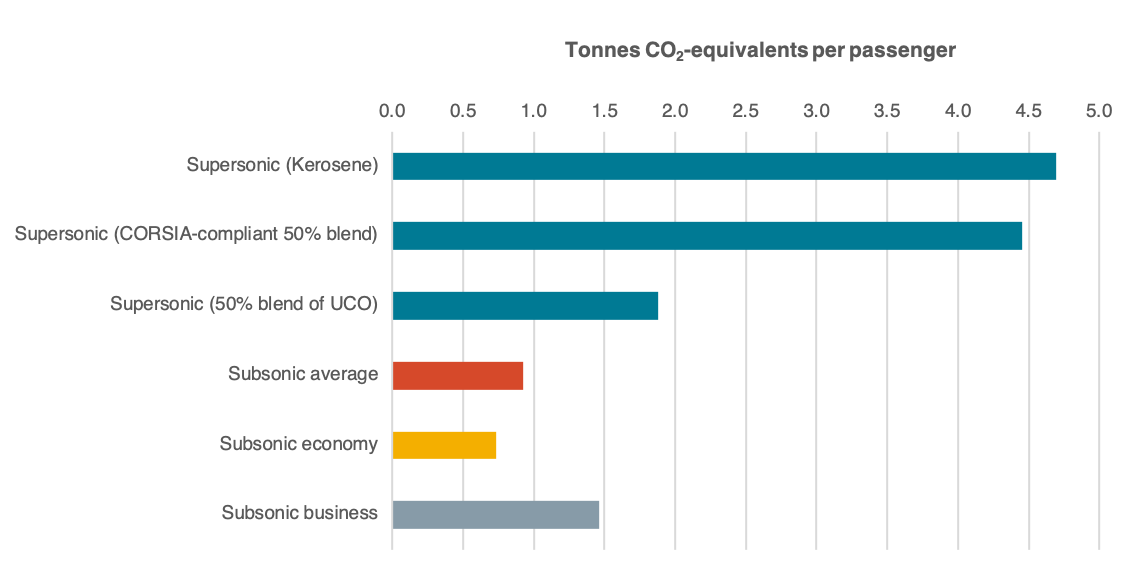Environmental performance of emerging supersonic transport aircraft
Blog
Supersonic air travel: Moving away from our climate commitments, faster than ever
Over the last year, the press has indulged readers with a series of glowing profiles and speculation about the gutsy start-ups vowing to revive the glamour and speed of supersonic transport (SST) aircraft. These articles often treat the climate and environmental risks with supersonic travel as an afterthought—a small problem that can be dismissed with vague assurances about engine efficiency and alternative fuels. While it is likely that supersonic airplanes consume fuel at a greater rate than their conventional counterparts, could that extra fuel burn be mitigated through the use of alternative fuels?
Last month, the International Civil Aviation Organization (ICAO) held a stocktaking seminar, bringing together alternative jet fuel (AJF) experts, regulators, and the aviation industry to develop a tangible, quantified vision for sustainable aviation fuel. The seminar culminated with a projection of the volumes of alternative fuels that could be available worldwide in 2025, based on input from seminar participants. Despite significant fanfare from ICAO and the aviation industry, ICAO projects (based off of seminar feedback) that only 1 to 5 billion liters of AFJ will actually be produced annually in 2025. That’s roughly 1% of the total projected jet fuel demand that year—and less than 3 months of fuel-use growth last year. The International Air Transport Association has set a target of a 2% uptake of AJF by 2025.
As we’ve pointed out previously, CORSIA provides a weak incentive for the in-sector carbon reductions due to the low implied offsetting costshas yet to be determined. If SST operators opt for alternative fuels in lieu of uncertain carbon offsets, the aggregate impact of their deployment can vary significantly depending on which fuels are used and at what blend level.
To assess the impact of alternative fuels on SST emissions, let’s start with a hypothetical example of a likely future SST route, popular during the Concorde’s heyday: a roundtrip flight between New York’s JFK airport and London’s Heathrow airport. A previous ICCT analysis estimates that a modeled SST based off of publicly-disclosed specifications carrying 55 passengers along that route would burn roughly 1,220 kg of kerosene per passenger—equivalent to roughly 2.3 tonnes of carbon (using a life-cycle emission factor of 89 grams of CO2-equivalents per MJ of fuel). On a per-passenger basis, this is 3 to 6 times the per-passenger emissions for an equivalent subsonic flight on an Airbus A-321LR, depending on seating.
Given ICAO’s current thinking on sustainability criteria for alternative fuels, it’s likely that the minimum threshold to qualify is a 10% life-cycle GHG reduction, equivalent to roughly 80gCO2e per MJ of fuel. Likely the best-performing fuel with near-term commercial prospects is hydroprocessed esters and fatty acids (HEFA) fuel made from used cooking oil, which has roughly an 80% GHG reduction relative to conventional jet fuel. However, the current generation of alternative jet fuels are only certified to be blended at 10 to 50% for commercial use, meaning that, in the near-term at least, the per-flight emissions reductions from their use will likely be halved due to blend restrictions. Therefore, for that SST flight to London, using the bare minimum CORSIA-eligible fuel barely makes a dent in the per-passenger emissions (5%), whereas even a blend of UCO-based HEFA would make a 40% cut. An SST powered by UCO-based HEFA at the maximum blend level will still generate twice the per-passenger emissions of an average, conventional flight, as shown in the figure below.

(Note: These emissions reflect the well-to-wake (WtWa) emissions for each fuel, including the upstream emissions from extraction, processing and distribution)
Then there’s the question of cost. Today’s aspiring manufacturers are marketing supersonic travel to the masses – one CEO recently predicted fares as low as 100 GBP from the UK — but in order for that to work, ticket prices need to stay low. With SSTs likely to be five to seven times as fuel intensive as subsonic aircraft, the cost of supplying them with alternative fuels would be sky high. Even the cheapest alternative fuel available in the near-term, HEFA produced from used cooking oil, costs over twice the wholesale price of kerosene to produce. At those prices, fueling an SST with a 50/50 HEFA blend would cost roughly 10 times that of conventional jet fuel. Will that be affordable for the masses?
While the production of alternative jet fuels ramps up in fits and starts, the rising demand for aviation fuels shows no signs of abating. Assuming one future commercial SST manufacturer (Boom) meets its sales targets, we predict that airlines’ supersonic fuel use could reach about 25 billion liters in 2035, or about 7% of total international aviation fuel use projected for that year. With so little alternative jet fuel to go around, it begs the question whether its deployment can sufficiently mitigate emissions from conventional air travel, much less the introduction of fuel-hungry SSTs.
Given the disparity in raw fuel consumption for SSTs relative to commercial subsonic flights, putting alternative jet fuels into SSTs not only fails to mitigate the added emissions attributable to the industry, but also presents an important opportunity cost: diverting limited supplies of alternative fuels to SSTs carrying a handful of passengers denies that emissions reduction opportunity to a greater number of subsonic travelers. Alternative fuels for SSTs, at least in the near-term, does little to help meet the industry’s climate obligation and does not mitigate the underlying problem: high fuel burn. A meaningful alternative would be for the SST industry to instead commit to meeting existing emissions standards.
